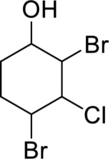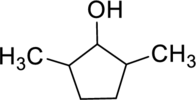
GENERAL, ORGANIC, BIOCHEM (LL W/ ACCESS)
10th Edition
ISBN: 9781260885958
Author: Denniston
Publisher: MCG
expand_more
expand_more
format_list_bulleted
Concept explainers
Question
Chapter 12.2, Problem 12.2Q
(a)
Interpretation Introduction
Interpretation:
Common name and IUPAC name for the given compound has to be given.

Concept Introduction:
A common nomenclature of naming organic compounds has been developed by IUPAC. By usage of this nomenclature or rules, memorizing of names of organic compounds is not necessary.
IUPAC rules for naming alcohols:
- Alcohols are named by identifying the parent compound and replacing the –e ending with –ol.
- Lowest possible number should be given for the hydroxyl group present in the parent chain.
- Name and number all substituent, and put them as prefixes to “alkanol” name also give the first preference as per the alphabetical order.
- If an alcohol contains two hydroxyl groups then name it as
diol , an alcohol; contains three hydroxyl groups then name it as triol. - Common names for alcohols are derived from alkyl group corresponding to the parent compound.
(b)
Interpretation Introduction
Interpretation:
Common name and IUPAC name for the given compound has to be given.

Concept Introduction:
Refer part (a).
(c)
Interpretation Introduction
Interpretation:
Common name and IUPAC name for the given compound has to be given.

Concept Introduction:
Refer part (a).
(d)
Interpretation Introduction
Interpretation:
Common name and IUPAC name for the given compound has to be given.

Concept Introduction:
Refer part (a).
Expert Solution & Answer
Want to see the full answer?
Check out a sample textbook solution
Students have asked these similar questions
4. Provide a clear arrow-pushing mechanism for each of the following reactions. Do not skip proton
transfers, do not combine steps, and make sure your arrows are clear enough to be interpreted
without ambiguity.
a.
2.
1. LDA
3. H3O+
HO
b.
H3C CH3
H3O+
✓ H
OH
2. Provide reagents/conditions to accomplish the following syntheses. More than one step is
required in some cases.
a.
CH3
Chapter 12 Solutions
GENERAL, ORGANIC, BIOCHEM (LL W/ ACCESS)
Ch. 12.1 - Prob. 12.1PPCh. 12.2 - Prob. 12.2PPCh. 12.2 - Prob. 12.3PPCh. 12.2 - Prob. 12.1QCh. 12.2 - Prob. 12.2QCh. 12.4 - Write an equation representing the reduction of...Ch. 12.4 - Write an equation representing the reduction of...Ch. 12.4 - Prob. 12.6PPCh. 12.4 - Prob. 12.7PPCh. 12.4 - Prob. 12.8PP
Ch. 12.4 - Prob. 12.3QCh. 12.4 - Prob. 12.4QCh. 12.4 - Prob. 12.5QCh. 12.4 - Prob. 12.6QCh. 12.4 - Prob. 12.7QCh. 12.4 - Prob. 12.8QCh. 12.6 - Prob. 12.9QCh. 12.6 - Prob. 12.10QCh. 12.7 - Name the following ethers using IUPAC...Ch. 12.7 - Prob. 12.10PPCh. 12.7 - Prob. 12.11PPCh. 12.7 - Prob. 12.11QCh. 12.7 - Prob. 12.12QCh. 12.8 - Prob. 12.12PPCh. 12 - Prob. 12.13QPCh. 12 - Prob. 12.14QPCh. 12 - Prob. 12.15QPCh. 12 - Prob. 12.16QPCh. 12 - Prob. 12.17QPCh. 12 - Prob. 12.18QPCh. 12 - Prob. 12.19QPCh. 12 - Prob. 12.20QPCh. 12 - Stingless bees use complex systems to communicate....Ch. 12 - Prob. 12.22QPCh. 12 - Prob. 12.23QPCh. 12 - Prob. 12.24QPCh. 12 - Prob. 12.25QPCh. 12 - Prob. 12.26QPCh. 12 - Prob. 12.27QPCh. 12 - Prob. 12.28QPCh. 12 - Prob. 12.29QPCh. 12 - Prob. 12.30QPCh. 12 - Prob. 12.31QPCh. 12 - Prob. 12.32QPCh. 12 - Prob. 12.33QPCh. 12 - Prob. 12.34QPCh. 12 - Prob. 12.35QPCh. 12 - Prob. 12.36QPCh. 12 - Prob. 12.37QPCh. 12 - Prob. 12.38QPCh. 12 - Prob. 12.39QPCh. 12 - Prob. 12.40QPCh. 12 - Prob. 12.41QPCh. 12 - Prob. 12.42QPCh. 12 - Prob. 12.43QPCh. 12 - Prob. 12.44QPCh. 12 - Prob. 12.45QPCh. 12 - Prob. 12.46QPCh. 12 - Prob. 12.47QPCh. 12 - Prob. 12.48QPCh. 12 - Prob. 12.49QPCh. 12 - Prob. 12.50QPCh. 12 - Prob. 12.51QPCh. 12 - Prob. 12.52QPCh. 12 - Prob. 12.53QPCh. 12 - Prob. 12.54QPCh. 12 - Prob. 12.55QPCh. 12 - Prob. 12.56QPCh. 12 - Prob. 12.57QPCh. 12 - Prob. 12.58QPCh. 12 - Prob. 12.59QPCh. 12 - Prob. 12.60QPCh. 12 - Prob. 12.61QPCh. 12 - Prob. 12.62QPCh. 12 - Prob. 12.63QPCh. 12 - Prob. 12.64QPCh. 12 - Prob. 12.65QPCh. 12 - Prob. 12.66QPCh. 12 - Prob. 12.67QPCh. 12 - Prob. 12.68QPCh. 12 - Prob. 12.69QPCh. 12 - Prob. 12.70QPCh. 12 - Prob. 12.71QPCh. 12 - Prob. 12.72QPCh. 12 - Prob. 12.73QPCh. 12 - Prob. 12.74QPCh. 12 - Prob. 12.75QPCh. 12 - Prob. 12.76QPCh. 12 - Prob. 12.77QPCh. 12 - Prob. 12.78QPCh. 12 - Prob. 12.79QPCh. 12 - Prob. 12.80QPCh. 12 - Prob. 12.81QPCh. 12 - Prob. 12.82QPCh. 12 - Prob. 12.83QPCh. 12 - Prob. 12.84QPCh. 12 - Prob. 12.85QPCh. 12 - Write the IUPAC and common name for each of the...Ch. 12 - Prob. 12.87QPCh. 12 - Prob. 12.88QPCh. 12 - Prob. 12.89QPCh. 12 - Prob. 12.90QPCh. 12 - Prob. 12.91QPCh. 12 - Prob. 12.92QPCh. 12 - Prob. 1MCPCh. 12 - Prob. 2MCPCh. 12 - Prob. 3MCPCh. 12 - Prob. 4MCPCh. 12 - Prob. 10MCPCh. 12 - Prob. 11MCP
Knowledge Booster
Learn more about
Need a deep-dive on the concept behind this application? Look no further. Learn more about this topic, chemistry and related others by exploring similar questions and additional content below.Similar questions
- Identify and provide an explanation that distinguishes a qualitative and quantitative chemical analysis. Provide examples.arrow_forwardIdentify and provide an explanation of the operational principles behind a Atomic Absorption Spectrometer (AAS). List the steps involved.arrow_forwardInstructions: Complete the questions in the space provided. Show all your work 1. You are trying to determine the rate law expression for a reaction that you are completing at 25°C. You measure the initial reaction rate and the starting concentrations of the reactions for 4 trials. BrO³¯ (aq) + 5Br¯ (aq) + 6H* (aq) → 3Br₂ (l) + 3H2O (l) Initial rate Trial [BrO3] [H*] [Br] (mol/L) (mol/L) | (mol/L) (mol/L.s) 1 0.10 0.10 0.10 8.0 2 0.20 0.10 0.10 16 3 0.10 0.20 0.10 16 4 0.10 0.10 0.20 32 a. Based on the above data what is the rate law expression? b. Solve for the value of k (make sure to include proper units) 2. The proposed reaction mechanism is as follows: i. ii. BrО¸¯ (aq) + H+ (aq) → HBrO3 (aq) HBrO³ (aq) + H* (aq) → H₂BrO3* (aq) iii. H₂BrO³* (aq) + Br¯ (aq) → Br₂O₂ (aq) + H2O (l) [Fast] [Medium] [Slow] iv. Br₂O₂ (aq) + 4H*(aq) + 4Br(aq) → 3Br₂ (l) + H2O (l) [Fast] Evaluate the validity of this proposed reaction. Justify your answer.arrow_forward
- a. H3C CH3 H, 1.0 equiv. Br2arrow_forwardH3C. H3C CH 3 CH 3 CH3 1. LDA 2. PhSeCl 3. H2O2arrow_forwardPlease predict the products for each of the following reactions: 1.03 2. H₂O NaNH, 1. n-BuLi 2. Mel A H₂ 10 9 0 H2SO4, H₂O HgSO4 Pd or Pt (catalyst) B 9 2 n-BuLi ♡ D2 (deuterium) Lindlar's Catalyst 1. NaNH2 2. EtBr Na, ND3 (deuterium) 2. H₂O2, NaOH 1. (Sia)2BH с Darrow_forward
- in the scope of ontario SCH4U grade 12 course, please show ALL workarrow_forwardIs the chemical reaction CuCl42-(green) + 4H2O <==> Cu(H2O)42+(blue) + 4Cl- exothermic or endothermic?arrow_forwardIf we react tetraethoxypropane with hydrazine, what is the product obtained (explain its formula). State the reason why the corresponding dialdehyde is not used.arrow_forward
arrow_back_ios
SEE MORE QUESTIONS
arrow_forward_ios
Recommended textbooks for you
 ChemistryChemistryISBN:9781305957404Author:Steven S. Zumdahl, Susan A. Zumdahl, Donald J. DeCostePublisher:Cengage Learning
ChemistryChemistryISBN:9781305957404Author:Steven S. Zumdahl, Susan A. Zumdahl, Donald J. DeCostePublisher:Cengage Learning ChemistryChemistryISBN:9781259911156Author:Raymond Chang Dr., Jason Overby ProfessorPublisher:McGraw-Hill Education
ChemistryChemistryISBN:9781259911156Author:Raymond Chang Dr., Jason Overby ProfessorPublisher:McGraw-Hill Education Principles of Instrumental AnalysisChemistryISBN:9781305577213Author:Douglas A. Skoog, F. James Holler, Stanley R. CrouchPublisher:Cengage Learning
Principles of Instrumental AnalysisChemistryISBN:9781305577213Author:Douglas A. Skoog, F. James Holler, Stanley R. CrouchPublisher:Cengage Learning Organic ChemistryChemistryISBN:9780078021558Author:Janice Gorzynski Smith Dr.Publisher:McGraw-Hill Education
Organic ChemistryChemistryISBN:9780078021558Author:Janice Gorzynski Smith Dr.Publisher:McGraw-Hill Education Chemistry: Principles and ReactionsChemistryISBN:9781305079373Author:William L. Masterton, Cecile N. HurleyPublisher:Cengage Learning
Chemistry: Principles and ReactionsChemistryISBN:9781305079373Author:William L. Masterton, Cecile N. HurleyPublisher:Cengage Learning Elementary Principles of Chemical Processes, Bind...ChemistryISBN:9781118431221Author:Richard M. Felder, Ronald W. Rousseau, Lisa G. BullardPublisher:WILEY
Elementary Principles of Chemical Processes, Bind...ChemistryISBN:9781118431221Author:Richard M. Felder, Ronald W. Rousseau, Lisa G. BullardPublisher:WILEY

Chemistry
Chemistry
ISBN:9781305957404
Author:Steven S. Zumdahl, Susan A. Zumdahl, Donald J. DeCoste
Publisher:Cengage Learning

Chemistry
Chemistry
ISBN:9781259911156
Author:Raymond Chang Dr., Jason Overby Professor
Publisher:McGraw-Hill Education

Principles of Instrumental Analysis
Chemistry
ISBN:9781305577213
Author:Douglas A. Skoog, F. James Holler, Stanley R. Crouch
Publisher:Cengage Learning

Organic Chemistry
Chemistry
ISBN:9780078021558
Author:Janice Gorzynski Smith Dr.
Publisher:McGraw-Hill Education

Chemistry: Principles and Reactions
Chemistry
ISBN:9781305079373
Author:William L. Masterton, Cecile N. Hurley
Publisher:Cengage Learning

Elementary Principles of Chemical Processes, Bind...
Chemistry
ISBN:9781118431221
Author:Richard M. Felder, Ronald W. Rousseau, Lisa G. Bullard
Publisher:WILEY
Lipids - Fatty Acids, Triglycerides, Phospholipids, Terpenes, Waxes, Eicosanoids; Author: The Organic Chemistry Tutor;https://www.youtube.com/watch?v=7dmoH5dAvpY;License: Standard YouTube License, CC-BY